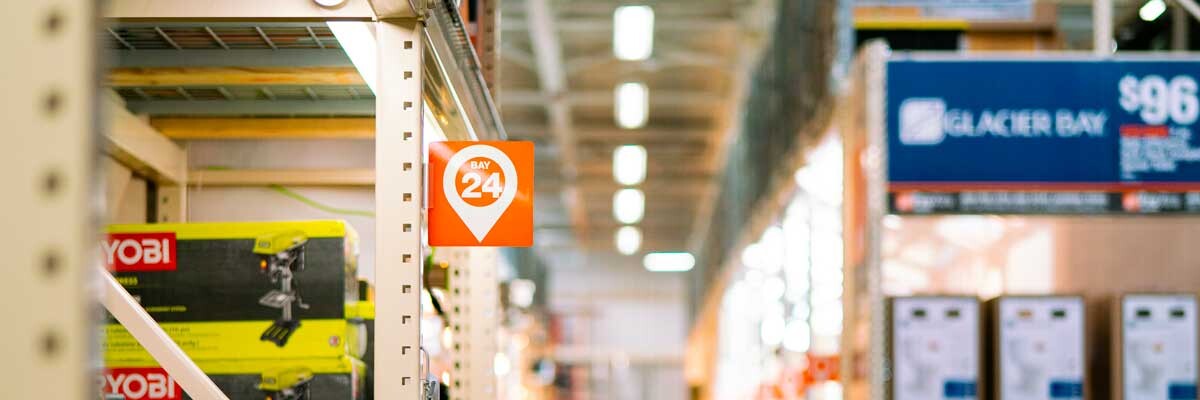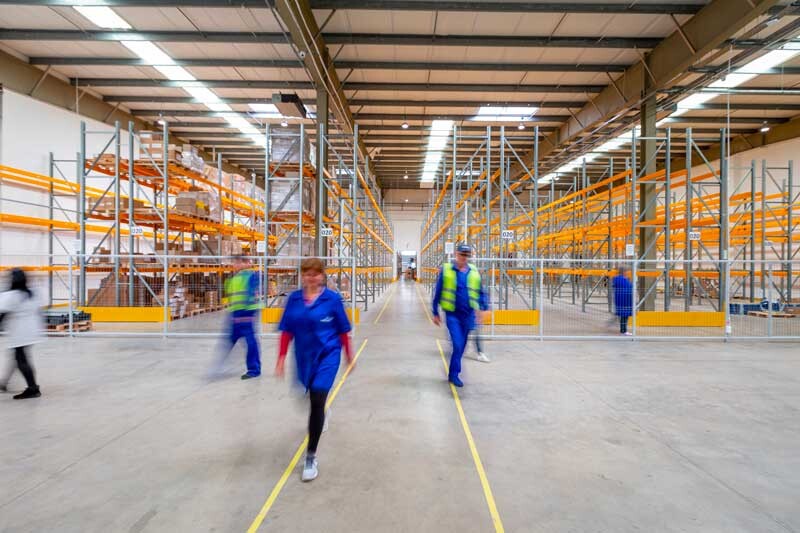Revolutionize Your Retail: 4 Proven Strategies to Enhance Logistics Efficiency
2023-12-29
Nowadays, the retail sector is constantly on the move and competition between retail companies is on the rise. In order for retail businesses to survive and thrive in this dynamic environment, it is essential to have efficient logistics and reliable supply chain processes. With growing demand, rapid changes in customer preferences and increasing competition, retail businesses must adapt and find ways to increase the efficiency and productivity of their logistics operations.

Retail logistics encompasses a wide range of activities
- from inventory management and warehouse operations,
- to transport planning,
- distribution of goods,
- and the management of complaints and returns.
It is a complex process that requires careful coordination and management of all stakeholders, including suppliers, manufacturers and retailers.
That is why it is important to have logistics flows that can
- deliver orders faster and more accurately,
- minimise shipping errors,
- and optimize operating costs.
Deploying a WMS system is one way to effectively achieve these goals.
A WMS system is a software solution that helps automate and optimize logistics processes in warehouses. Using this technology, retail businesses can achieve significant improvements in their logistics and increase their competitiveness in the market.
These are 4 ways a WMS can improve logistics in retail.
1. Acceleration of goods receipt
In retail logistics, we are often faced with challenges associated with receiving goods, and speed and accuracy are absolutely essential. A WMS system allows for the automation of receiving processes, eliminating the chance of errors. In addition, it provides the tools for detailed tracking and analysis of goods movements, enabling continuous optimization and improvement of receiving procedures.
The result is not only faster receipt of goods, but also accurate and up-to-date data in the records, which ultimately leads to increased efficiency and productivity of the entire logistics and warehousing process.
This integrated approach ensures that all goods received are correctly recorded, processed and ready for onward distribution or sale in record time.
Benefits of WMS on goods receipt:
- Automation of receiving operations: manual handling is minimized, reducing the possibility of errors and speeding up the entire process.
- Accurate goods registration: Instant scanning and updating of databases ensures accurate recording of incoming goods
- Warehouse space optimization: the WMS can suggest the optimal placement of goods based on their size, weight or rotation
- Accelerating the receiving process: Automation and efficient tracking make goods ready for stocking or further distribution faster
- Improved quality control: The system can include checklists or protocols to verify the quality of incoming goods
- Reduced Human Error: Digitization reduces the need for manual recording, resulting in more accurate records and fewer discrepancies in record-keeping
- Quick identification of problems: In the event of discrepancies or delivery problems, WMS enables quick identification and offers immediate resolution
- Real-time traceability of goods: The ability to track goods from the moment they arrive to the moment they are placed in stock and dispatched
- Employee Efficiency: Enables warehouse staff to better plan and deliver operations with greater productivity
- Integration with other systems: Can be linked to supplier systems, order management systems or other logistics or accounting solutions for a holistic view of operations and transactions

2. Optimization of warehouse operations
Within retail logistics, warehouse operations are of central importance, directly affecting the speed, efficiency and reliability of the entire distribution chain. There is now a need for warehouse operations to be performed with maximum accuracy and minimized room for error, which is key to success in the increasingly competitive retail environment.
A modern WMS system is specifically designed to address the complex challenges that are associated with these operations. One of the main technical solutions offered by a WMS is intelligent stacking of goods in warehouse areas.
The system uses algorithms and historical goods movement data to optimize the placement of goods depending on their frequency of shipment and seasonality. This means that goods that are in high demand are placed in more accessible areas, minimising the movement of staff picking orders and therefore increasing the speed of warehouse processes.
Another important function of a WMS is the accurate tracking of warehouse locations. With advanced technologies such as barcode scanners, RFID chips and integrated sensors, every item in the warehouse is accurately identified and tracked in real time. This tracking
- eliminates time-consuming searching for goods,
- minimizes the possibility of loss or substitution for similar goods,
- and enables faster responses to changes in demand or inventory levels.
Benefits of WMS for warehouse operations:
- Intelligent items placement: the WMS optimizes the arrangement of goods in the warehouse based on their popularity and seasonality, minimizing unnecessary movements and increasing the efficiency of order-picking
- Accurate tracking of warehouse locations: thanks to integrated technologies such as barcode scanners and RFID chips, every item in the warehouse can be identified and tracked in real-time at any time
- Reducing warehouse errors: Advanced WMS features such as automated checks and receipts greatly reduce the possibility of errors when loading and unloading goods
- Inventory optimization: WMS provides an accurate view of current inventory levels, which helps in purchasing decisions and reduces the risk of stock shortages or overstock
- Speeding up processes: Automated operations such as express receiving and issuing of goods significantly reduce the time needed to pick up orders
- Improved work efficiency: the WMS provides tools for better organization and planning of warehouse workers, increasing their productivity and improving ergonomic conditions for their work
- Rapid adaptation to change: In the event of sudden changes in demand or inventory, the WMS system can be quickly adapted to respond to new conditions and circumstances
- Integration with other corporate or automation systems: the WMS integrates easily with other information systems within the company, allowing for seamless communication and data exchange between departments

3. Accurate inventory tracking and management
Proper and efficient inventory management is an integral process of retail logistics as it has a direct impact on
- customer satisfaction,
- time efficiency,
- and costs of the business.
A WMS system becomes an invaluable tool in this area as it brings a high level of accuracy and transparency to the entire inventory management process.
From the moment the goods enter the warehouse, through their storage, to their final dispatch to the customer, the WMS system tracks and records every step. The result is an up-to-date and detailed real-time overview of the warehouse inventory.
With this detailed traceability, the company is able to
- immediately identify potential stock shortages,
- prevent stock depletion,
- or unnecessary surpluses.
All this leads to
- more efficient order planning,
- optimizing operating costs,
- and reduce the risk of losses from inefficient supply or obsolescence.
In addition, when a company has accurate information about its inventory, it can adapt more quickly and efficiently to changes in the market or sudden fluctuations in customer demand. In this way, a WMS not only minimizes the potential financial losses caused by sub-optimal inventory management but also strengthens the competitiveness of the firm.
Benefits of WMS for inventory management:
- Real-time inventory updates: a WMS enables instant real-time tracking of inventory, providing up-to-date information on the quantity and location of goods
- Preventing stock-outs: By accurately tracking inventory levels, the WMS can automatically generate notifications of declining numbers of relevant goods and ensure quick reordering
- Reducing overstocks: the system can help identify goods that are overstocked or in low volume, thus ensuring optimization of stock holdings
- Preventing loss of goods: Controlling the movement and tracking of goods minimizes the risk of loss or theft
- Automatic identification of goods: thanks to integrated technology such as barcodes or RFID, the WMS can quickly and accurately identify individual goods items and carry out inventory more efficiently
- Inventory history: The system keeps a detailed record of all goods movements, allowing detailed trend analysis and better inventory planning for the future
- Space optimization: the WMS can suggest the optimal placement of goods in warehouse areas, resulting in more efficient use of warehouse space
- Error reduction: Accurate inventory tracking and automated processes minimize the possibility of human error when entering data or handling goods
- Rapid response to changes in demand: With up-to-date inventory data, retailers can quickly respond to sudden changes in customer demand
- Improved planning and forecasting: With detailed inventory visibility and historical data, a company can more accurately forecast future inventory needs and optimize ordering processes

4. Improved order picking
Implementing a WMS system comes with advanced tools to automate and optimize the order-picking process. This enables sophisticated methods such as
- batch picking,
- zone picking
- and dynamic warehouse organization,
which significantly reduce unnecessary employee changeovers and warehouse restocking. This minimizes waiting times and reduces errors in picking procedures.
Thanks to this optimization, the optimal time and place for picking goods can be determined more accurately, which significantly speeds up the ordering process. Faster and more accurate processing also ensures that customer orders are picked without unnecessary delays and with maximum accuracy.
In addition, when error rates are reduced, the costs associated with returns and claims are also minimized. Customers can therefore rely on receiving exactly what they ordered, on time and in perfect condition.
This consistency in delivery increases customer confidence in the brand and the company. And since a satisfied customer is often a loyal customer, such order-picking efficiency can increase repeat purchases and strengthen a company's reputation in the long run.
Benefits of WMS for improving order picking:
- Increased order accuracy: a WMS minimizes order errors by automating the picking and packing of goods
- Faster order processing: the system enables a faster and smoother order process, resulting in faster delivery of goods to customers
- Space optimization: the WMS suggests the most efficient routes for picking and storing goods, reducing the time required to pick and ship an order
- Automated order fulfillment: Integrated tools enable automated order processing, minimizing the need for manual labor
- Improved shipment tracking: The system provides accurate location of goods in the picking process, enabling better communication with customers about the status of their orders
- Customizability and flexibility: the WMS can be tailored to the specific needs of the business, ensuring efficient order management across different warehouse zones
- Reducing warehouse costs: Efficient order management leads to a reduction in excess inventory and thus a reduction in reorder costs
- Improved customer feedback: With a more accurate and faster ordering process, a business can provide better service and feedback to its customers
- Integration with other systems: the WMS can be easily integrated with other company systems, enabling seamless data transfer and better order management across different departments and branches
Within retail logistics, deploying a WMS system can be the difference between mediocre and excellent performance. Not only does it support more efficient receiving processes, but it also improves warehouse operations, ensures accurate inventory tracking, and increases the accuracy of the ordering process.
A WMS system is a comprehensive tool that covers various aspects of retail logistics, providing a holistic approach to improving overall warehouse and company operations.
- Automation of routine tasks,
- reducing errors
- and providing accurate inventory visibility
are just the beginning of what a WMS system can offer. Ultimately, it enables companies to continuously achieve higher levels of performance and provide a comfortable service to customers according to their expectations.







